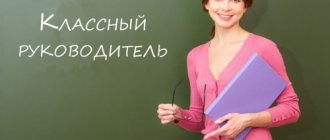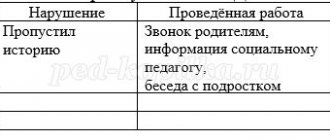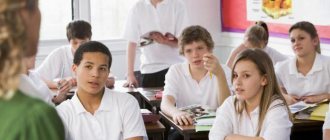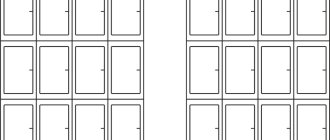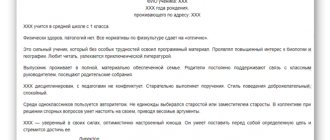Characteristics of a 4th grade student
Characteristics for a 4th grade student are most often compiled when a student is transferred from primary school to secondary school.
The primary school teacher is writing to provide information about the child to the new class teacher. In order for the picture to be as complete as possible, it is optimal to use psychological and pedagogical characteristics. It reveals the psychological characteristics of the student and his inclinations to study, attitude towards the educational process. Since the document is internal, the use of school forms is optional, but the signature of the originator and the date of writing must be present.
Due to the significant amount of work, because characteristics must be drawn up for all students in the group, the teacher is recommended to use a template that highlights all the qualities inherent in a particular child.
Speech therapy characteristics of a 4th grade student
Rimma Yausheva
Speech therapy characteristics of a 4th grade student
Speech therapy characteristics for 4th grade student Ekaterina K.
Speech rate is slow, speech breathing is difficult. There is a replacement [P]//[L]. Movements of the tongue and lips are slow and not precise enough. With an increase in speech load, general blurred speech occurs. There is an increase in tone in the muscles of the tongue and lips. The voice is quiet.
The vocabulary is close to the age norm. Has difficulty forming qualitative and relative adjectives. This indicates a low level of development of grammatical structure and immaturity of morphemic analysis. Inaccurate understanding and use of general concepts, words with abstract and abstract meaning, as well as words with figurative meaning. He makes no mistakes in agreeing between adjectives and nouns. Uses simple common sentences as well as some types of complex sentences. At the same time, their structure may be disrupted, for example, due to the absence of main or minor members of the sentence. In independent speech, the number of errors associated with changing words according to the grammatical categories of gender, number, case, person, and tense decreased. Phonemic perception and phonemic analysis and synthesis are basically formed. Able to identify the first and final sound, name words based on a given sound.
The sound quality of words suffers, and there are errors and distortions. Does not retain the full syllable structure of polysyllabic words.
Tasks for understanding logical and grammatical figures of speech associated with case forms do not cause any difficulties.
Phrasal speech is developed. Uses simple common sentences as well as some types of complex sentences. At the same time, their structure may be disrupted, for example, due to the absence of main or minor members of the sentence. In independent speech, the number of errors associated with changing words according to the grammatical categories of gender, number, case, person, and tense decreased. .When composing an independent story, as well as a story based on a picture or a series of pictures, agrammatisms are rare. Another type of coherent speech—text retelling—is a little better. There are no violations of logical-temporal connections in the narrative, does not rearrange parts of the story and does not omit important elements of the plot.
Speech therapy conclusion : General speech underdevelopment of level 3, reading and writing impairment caused by general speech underdevelopment.
A sample plan might look like this:
- General information. FULL NAME. Date of Birth. Date of admission to this educational institution.
- Family information. Family full/incomplete. Information about relatives living together.
- Physical state. Presence/absence of chronic diseases, deviations in physical development. Conditions of vision and hearing.
- Attitude to learning. Presence/lack of interest in learning, seriousness/frivolity, responsibility/carelessness, hard work/tendency to laziness, strong/weak student.
- Intellectual sphere. Attentive / absent-minded, remembers material well / poorly, imagination is developed / not, inclined to analyze information / not inclined.
- Activity in the classroom. High/low. Continuous/periodic.
- Emotional-volitional sphere. Discipline/lack of discipline, perseverance/excitability, responsibility/irresponsibility, acceptance/rejection of educational measures, high/adequate/low self-esteem.
- Communication sphere. Sociability/unsociability, openness/closedness, presence/absence of leadership qualities, friendliness/conflict.
- Moral and aesthetic qualities. Truthfulness/propensity to lie, presence/absence of empathy, desire to help others, integrity/unprincipledness.
- Hobbies. Presence/absence of hobbies. Information about attended clubs and sections.
Sample characteristics of a 4th grade student
Characteristics for a 4th grade student at the Municipal Educational Institution (name of educational institution)
Sergeev Stanislav Alexandrovich
Date of birth: 02/08/2008 Date of admission to school 09/01/2014
The family is complete. One child per family, lives only with parents.
He has no chronic diseases or deviations in physical development; there is a slight decrease in vision.
Shows interest in learning, is a serious, responsible, hardworking, strong student.
Attentive, remembers material well, tends to analyze information, has a well-developed imagination.
Activity in lessons is consistently high.
Disciplined, diligent, responsible, self-esteem is slightly high.
Sociable, friendly, open, strives for leadership in the team.
He is prone to fantasizing and distorting real facts, strives to be in the center of events, empathize and help others.
He is involved in the freestyle wrestling section.
The report card is attached. It shows that Stanislav’s grades are “excellent” and “good”; he is a positive student and does not need increased supervision or additional classes. It is recommended to pay special attention to the area of communication with peers.
Characteristics of the 4th grade class team
CHARACTERISTICS OF THE CLASS STAFF
4 CLASSES
for the 2015-2016 academic year
There are 20 people in the class: 10 boys and 10 girls.
There are no dysfunctional families.
Single-parent families: Telyukova L., Yudicheva D.
Large families: Velilyaeva L., Goncharova M., Dzhelilova E., Kiselev D., Neskreba M., Nesterov M., Telyukova L., Shabnova N., Shevchenko A.
There are no orphans or children under guardianship.
All students are diligent, neat, provided with textbooks and necessary school supplies. This suggests that parents care about their children. All children receive free hot meals (breakfast); children from large families receive two free meals a day.
The physical development of children corresponds to their age, but there are children who are often ill: Kashcheeva P., Bilobrovko V., Yudicheva D. They often miss lessons and suffer from colds. These children require constant monitoring and monitoring of their health status. There are delays for Mikhail Nesterov's classes. Explanatory work is being carried out with him and his parents to eliminate the causes of delays.
Many students in the class have developed a conscious motivation for high learning results and have a cognitive interest in learning.
According to the results of this year, academic performance is 100%.
Excellent students: Peev R., Zhigalova A.
Good students: 10 students.
With one “3”: Yudicheva D. (English).
There are no unsuccessful children.
There are children who should be classified as weak in certain subjects:
Dzhelilova E., Shevchenko A. (Russian language), Nesterov M. (Art, physical education),
Yudicheva D. (English). They are not closed, they are sociable, but one is distinguished by an extremely slow pace of activity, while the other, on the contrary, the process of excitation prevails over the process of inhibition, individually they are happy to give answers orally, their speech is quite literate.
During lessons, children show interest in learning activities, are almost always prepared, and can express their own opinions on questions posed. They have the ability to analyze, generalize, and draw independent conclusions. They are smart and can be creative in their mental activities.
The class has independent work skills. Some students are characterized by a slow pace of activity - Nesterov M., Yudicheva D., Musaev I. Do not show awareness and systematic knowledge - Shabnova N., Neskreba M., Kiselev D., cannot always draw independent conclusions, do not show breadth and flexibility of thinking . These students require additional stimulation and constant supervision from adults, as a result of which they can achieve some results.
The typical type of thinking for the class is concrete-conceptual. Visual-effective and visual-figurative thinking dominates (everything studied needs to be touched and seen).
The bulk of students in the class are children with a good level of abilities and high motivation to learn; they are able to master the program in the subject beyond the basic level. They are distinguished by good organization, discipline, and a responsible attitude towards completing schoolwork and homework. (Result: 2 excellent students and 10 good students)
It can be noted that all children are happy to carry out the teacher’s instructions: hand out notebooks, water flowers, and take responsibility for being on duty in the classroom.
The relationships between students are quite smooth and generally conflict-free.
Children are active, nimble, impulsive, and cheerful. Students love outdoor games and sports competitions, and actively take part in the preparation and holding of holidays both inside the classroom and within the school walls. They sing, dance, and act out fairy tales with pleasure.
Boys and girls are friends with each other.
The guys experience the successes and failures of their class and root for their team. When holding social events, they try to stay together.
The class always actively participates in school-wide events. All children in the class are involved in extracurricular and extracurricular activities, take part in school events, and also attend clubs and sections, taking into account their interests. All children attend extracurricular activities, as well as extracurricular institutions: music school (Dzhelilova E.)
There is no clear leader in the class. Any of the students in a certain situation can become and lead the rest. Most of the students in the class are open and easy to communicate with, but there are closed, distrustful children. (Shabnova Natasha, Neskreba Maxim), shy children (Yudicheva D., Biserov P.) The class is not conflicting, children easily make contact with teachers and classmates are involved in various activities.
Parents (and not only members of the parent committee) provide great assistance in organizing the work of the class. The parent committee works actively and productively: any question, any request does not go unnoticed. Parents pay a lot of attention to their children at home. The cool parent team is friendly, responsive, and ready to help.
Parents of students are people of different ages, different professions, differ from each other in their level of education, culture, and parental activity. Many parents have a positive influence on their children. They are distinguished by the unity and consistency of family requirements for children, awareness of the child’s life, close communication with the teacher, search for recommendations and resolution of problematic situations in raising children. All families are prosperous. They have average income.
Conclusions and recommendations:
in grade 5, the educational process and educational work must be planned taking into account the age and psychological characteristics of the children, which were discussed above;
continue to work on uniting the team, developing common value norms and rules;
to form adequate self-esteem in schoolchildren;
cultivate a culture of communication, develop communication skills;
to form positive motives in relationships with others.
Class teacher: Khanyuchenko N. A.
